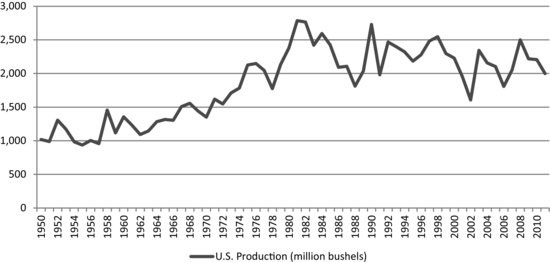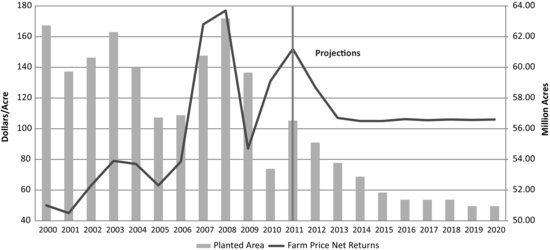25.5 FUNDAMENTAL ANALYSIS FOR DIRECTIONAL AND RELATIVE VALUE STRATEGIES
Directional and relative value strategies often depend on fundamental analysis for trade identification. Fundamental analysis in commodity investment involves identifying and predicting changes in supply and demand, including changes in inventory levels and cost of carry. The time frame of analysis depends on the horizon of the investment and the characteristics of the particular commodity in question. While much of the analysis may focus on shorter-term patterns (such as harvest season to harvest season), longer-term trends may also be considered, such as global demand growth due to emerging markets. A fundamental understanding of the commodity in question is essential. A brief description of the characteristics of wheat is provided next.
25.5.1 Fundamental Analysis: Understanding the Characteristics of Wheat
Wheat is a member of the grass family. It is the most prevalent cereal grain and provides more nourishment across the globe than any other food. It is believed to have originated near what is now Iraq, and has been consumed by humans since about 10,000 B.C. Although it was grown by colonists in America in the seventeenth century, wheat remained a relatively small crop in the United States until the late nineteenth century, when a hardy strain known as Turkey red wheat was brought to Kansas by Russian immigrants. Wheat is classified by growing season and further segmented by class. It is grown in two distinct growing seasons. Typically, about three-quarters of U.S. wheat production is made up of winter wheat, which is planted in the fall, lies dormant through the winter, grows in the spring, and is harvested in early summer. The remainder is spring wheat, which is planted in the spring, sprouts quickly, and is harvested in late summer or early fall. In addition to the growing season, wheat classes are based on the characteristics of the wheat, such as hardness and color. In the United States, wheat is classified in two winter classes: hard red winter (highest production and export levels, used for bread) and soft red winter (low protein, used for cakes). It is also classified into four spring classes: hard red spring (highest protein, excellent for breads); hard white (similar to red wheat, mostly consumed domestically); soft white (similar to soft red winter); and durum (hardest U.S. wheat, very little exported, used for semolina). (See Exhibit 25.4.)
Wheat is generally grown in arid regions with relatively poor soil quality. The particular temperature, soil, and rainfall of a region tend to determine which class of wheat is grown. Wheat production climbed significantly from 1950 to 1980, but it has been on a slight decline since 1980. This is partially due to the fact that wheat has no significant uses beyond food and feed production, while other crops, such as corn, have a variety of uses, including energy production. Since farmers will plant crops with the highest yield, the broader demand for corn may result in a reduced supply (and demand) of wheat.
China is the largest consumer of wheat, but the majority of its consumption is produced internally. The United States is the third largest producer of wheat (behind China and India), and the largest exporter of wheat (exporting close to half of its production).
Shortages of wheat during a season can be supplanted with wheat from other regions, since wheat is planted at different times of the year around the world. In addition, since wheat is generally consumed as flour, there are a number of substitutes available. While there are certainly differences in characteristics, flour can be made from corn, rice, beans, rye, and other crops.
Wheat marketing years vary across the globe, depending on a region's harvest date. In the United States, the wheat marketing year runs from June 1 to May 31. Wheat is usually harvested from June to September, progressively moving from Texas northward. Typically, about half of the wheat is sold at or before harvest, while the other half is stored. This excess supply at harvest depresses prices during the summer each year. Prices generally recover after the harvest, until excess supply appears again when wheat growers in the southern hemisphere begin their harvest in December.
Wheat futures in the United States trade on the Chicago Board of Trade (CBOT), the Kansas City Board of Trade (KCBT), and the Minneapolis Grain Exchange (MGE). The underlying class of wheat for CBOT wheat futures is generally considered to be soft red winter wheat, although the contract allows delivery of four different varieties of wheat. The KCBT contract specifies hard red winter wheat, while the MGE contract specifies hard red spring wheat. Wheat futures typically trade in contango, which entices producers to retain a portion of the wheat crop in storage throughout the marketing year. (See Exhibit 25.5.)


